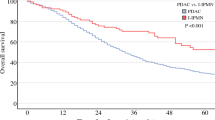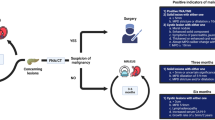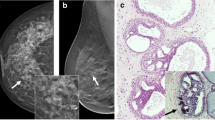Abstract
Purpose
Pancreatic intraepithelial neoplasia (PanIN) is a presumed precursor of pancreatic ductal adenocarcinoma (PDAC). We assessed the relationship between incidental PanIN after resection of non-adenocarcinoma lesions and the development of metachronous PDAC in the remnant.
Methods
We retrospectively reviewed the clinicopathologic data of patients who underwent pancreatectomy for non-PDAC from January 2000 to January 2010. Intraductal papillary mucinous lesions were excluded. All available postoperative imaging and clinical follow-up data were reviewed; the risk of developing PDAC was assessed in patients with a minimum follow-up time of 6 months and with imaging studies available for review.
Results
A total of 584 patients were analyzed. Median age was 59 years (range 10–85 years), and 338 (58 %) were female. The most common lesions for which resection was performed were serous cystic neoplasms (17 %), pancreatic neuroendocrine tumors (38 %), metastatic tumors (9 %), and mucinous cystic neoplasms (7 %). PanIN was identified in 153 (26 %) patients. The majority of these patients had PanIN-1 or -2 (50 and 41 %, respectively), whereas 13 (8 %) had PanIN-3. Of the 506 (87 %) patients with adequate follow-up (median 3.7 years, range 0.5–12.6 years), 1 patient (0.2 %) with PanIN identified at the time of initial resection developed cancer in the remnant. This occurred 4.4 years after a distal pancreatectomy in the setting of PanIN-1B. No patient with PanIN-3 developed cancer during follow-up.
Conclusions
PanIN was identified in 26 % of patients who underwent resection for histopathology other than PDAC. The presence of PanIN of any grade did not result in an appreciable cancer risk in the pancreatic remnant after short-term follow-up.
Similar content being viewed by others
References
Vincent A, Herman J, Schulick R, et al. Pancreatic cancer. Lancet. 2011;378:607–20.
Hruban RH, Takaori K, Klimstra DS, et al. An illustrated consensus on the classification of pancreatic intraepithelial neoplasia and intraductal papillary mucinous neoplasms. Am J Surg Pathol. 2004;28:977–87.
Hruban RH, Adsay NV, Albores-Saavedra J, et al. Pancreatic intraepithelial neoplasia: a new nomenclature and classification system for pancreatic duct lesions. Am J Surg Pathol. 2001;25:579–86.
Iacobuzio-Donahue CA. Genetic evolution of pancreatic cancer: lessons learnt from the pancreatic cancer genome sequencing project. Gut. 2012;61:1085–94.
Hruban RH, Goggins M, Parsons J, et al. Progression model for pancreatic cancer. Clin Cancer Res. 2000;6:2969–72.
Stelow EB, Adams RB, Moskaluk CA. The prevalence of pancreatic intraepithelial neoplasia in pancreata with uncommon types of primary neoplasms. Am J Surg Pathol. 2006;30:36–41.
Andea A, Sarkar F, Adsay VN. Clinicopathological correlates of pancreatic intraepithelial neoplasia: a comparative analysis of 82 cases with and 152 cases without pancreatic ductal adenocarcinoma. Mod Pathol. 2003;16:996–1006.
Brat DJ, Lillemoe KD, Yeo CJ, et al. Progression of pancreatic intraductal neoplasias to infiltrating adenocarcinoma of the pancreas. Am J Surg Pathol. 1998;22:163–9.
Brockie E, Anand A, Albores-Saavedra J. Progression of atypical ductal hyperplasia/carcinoma in situ of the pancreas to invasive adenocarcinoma. Ann Diagn Pathol. 1998;2:286–92.
Takaori K, Matsusue S, Fujikawa T, et al. Carcinoma in situ of the pancreas associated with localized fibrosis: a clue to early detection of neoplastic lesions arising from pancreatic ducts. Pancreas. 1998;17:102–5.
Almoguera C, Shibata D, Forrester K, et al. Most human carcinomas of the exocrine pancreas contain mutant c-K-ras genes. Cell. 1988;53:549–54.
Hu YX, Watanabe H, Ohtsubo K, et al. Frequent loss of p16 expression and its correlation with clinicopathological parameters in pancreatic carcinoma. Clin Cancer Res. 1997;3:1473–7.
Ruggeri B, Zhang SY, Caamano J, et al. Human pancreatic carcinomas and cell lines reveal frequent and multiple alterations in the p53 and Rb-1 tumor-suppressor genes. Oncogene. 1992;7:1503–11.
Schutte M, Hruban RH, Hedrick L, et al. DPC4 gene in various tumor types. Cancer Res. 1996;56:2527–30.
Mazur PK, Einwachter H, Lee M, et al. Notch2 is required for progression of pancreatic intraepithelial neoplasia and development of pancreatic ductal adenocarcinoma. Proc Natl Acad Sci USA. 2010;107:13438–43.
Recavarren C, Labow DM, Liang J, et al. Histologic characteristics of pancreatic intraepithelial neoplasia associated with different pancreatic lesions. Hum Pathol. 2011;42:18–24.
Shi C, Klein AP, Goggins M, et al. Increased prevalence of precursor lesions in familial pancreatic cancer patients. Clin Cancer Res. 2009;15:7737–43.
McCarthy DM, Brat DJ, Wilentz RE, et al. Pancreatic intraepithelial neoplasia and infiltrating adenocarcinoma: analysis of progression and recurrence by DPC4 immunohistochemical labeling. Hum Pathol. 2001;32:638–42.
Matthaei H, Hong SM, Mayo SC, et al. Presence of pancreatic intraepithelial neoplasia in the pancreatic transection margin does not influence outcome in patients with R0 resected pancreatic cancer. Ann Surg Oncol. 2011;18:3493–9.
Kim J, Reber HA, Dry SM, et al. Unfavourable prognosis associated with K-ras gene mutation in pancreatic cancer surgical margins. Gut. 2006;55:1598–605.
Ferrone CR, Tang LH, Tomlinson J, et al. Determining prognosis in patients with pancreatic endocrine neoplasms: can the WHO classification system be simplified? J Clin Oncol. 2007;25:5609–15.
Sakorafas GH, Smyrniotis V, Reid-Lombardo KM, Sarr MG. Primary pancreatic cystic neoplasms revisited. Part I: serous cystic neoplasms. Surg Oncol. 2011;20:e84–92
Agoff SN, Crispin DA, Bronner MP, et al. Neoplasms of the ampulla of Vater with concurrent pancreatic intraductal neoplasia: a histological and molecular study. Mod Pathol. 2001;14:139–46.
Canto MI, Hruban RH, Fishman EK, et al. Frequent detection of pancreatic lesions in asymptomatic high-risk individuals. Gastroenterology. 2012;142:796–804.
Kelly KA, Bardeesy N, Anbazhagan R, et al. Targeted nanoparticles for imaging incipient pancreatic ductal adenocarcinoma. PLoS Med. 2008;5:e85.
Conflict of interest
The authors declare no conflict of interest.
Author information
Authors and Affiliations
Corresponding author
Rights and permissions
About this article
Cite this article
Konstantinidis, I.T., Vinuela, E.F., Tang, L.H. et al. Incidentally Discovered Pancreatic Intraepithelial Neoplasia: What Is Its Clinical Significance?. Ann Surg Oncol 20, 3643–3647 (2013). https://doi.org/10.1245/s10434-013-3042-2
Received:
Published:
Issue Date:
DOI: https://doi.org/10.1245/s10434-013-3042-2




